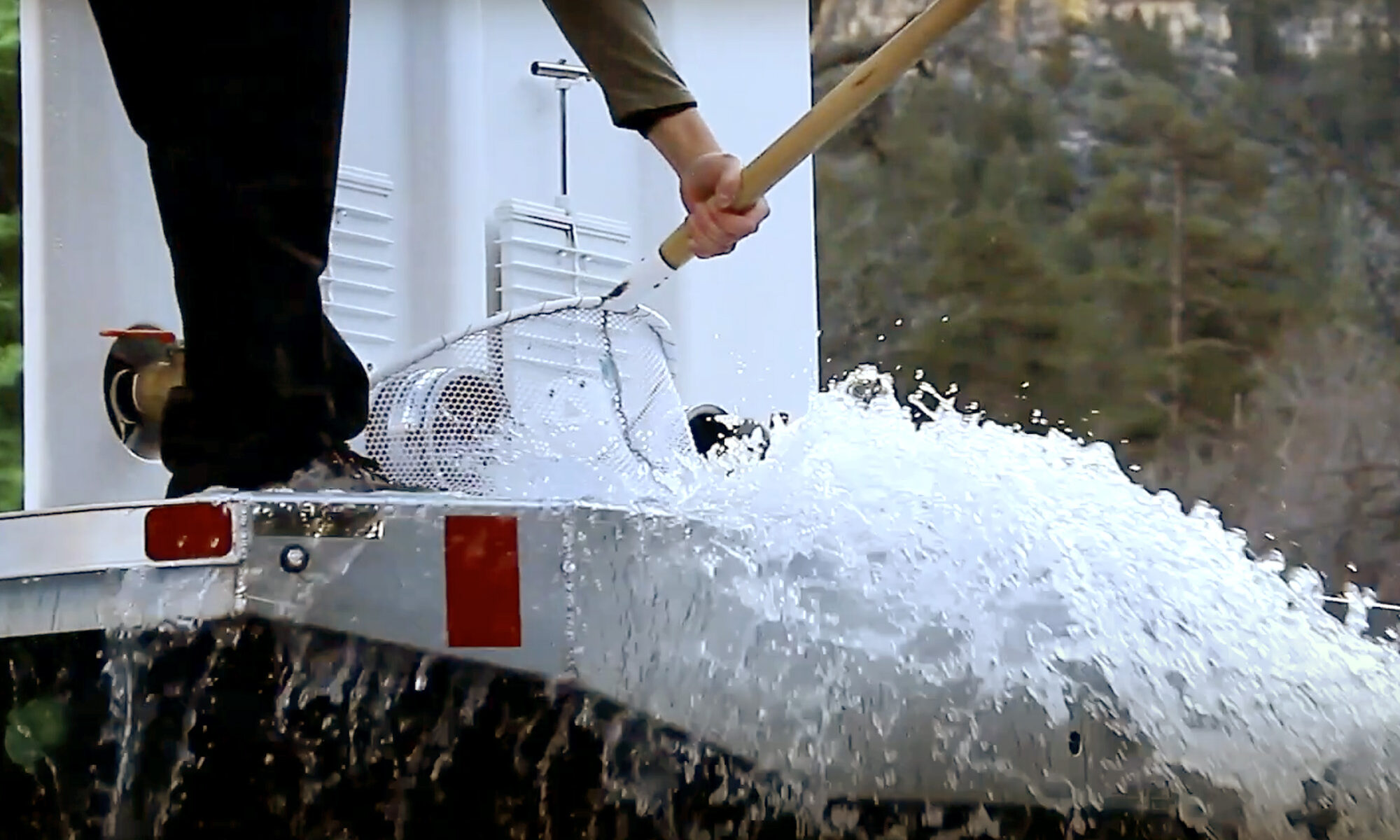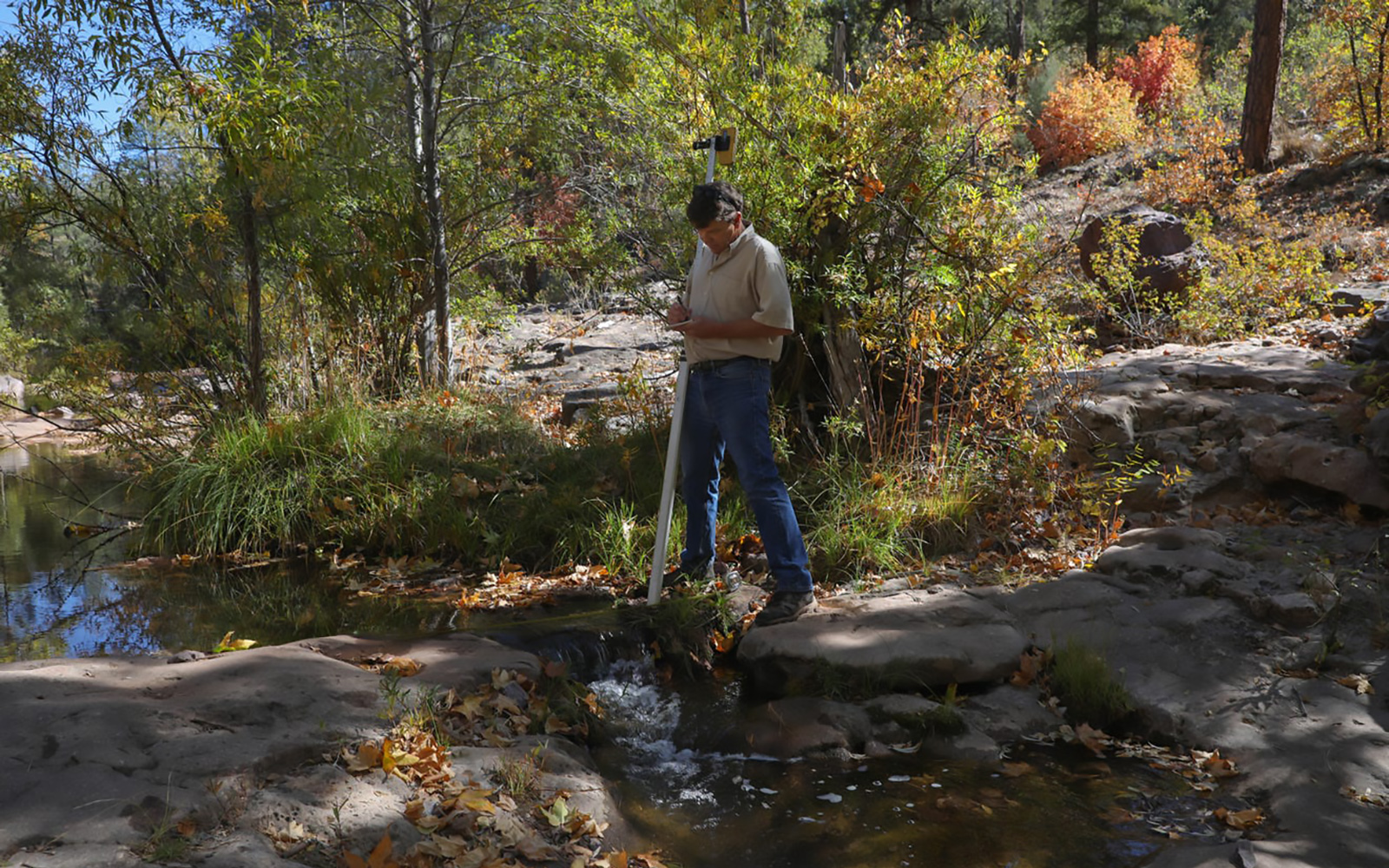PAYSON — Intermittent drops of water trickle out of a suspended pipe bridging two banks of Christopher Creek. The water rings from the leak are the only disturbance to the sedimented surface. Beneath it, few native fish still survive.
Drier seasons, hotter temperatures, steady erosion and a lack of maintenance has led to warmer waters and an increase in soil in the waterbody. This had made portions of the creek unsustainable to some native wildlife.
Now, organizations like the Boy Scouts of America and Trout Unlimited are investing in the creek’s restoration. Their work will address affected areas by improving cold-water flow, supporting soil banks and reintroducing native fish. By cooling temperatures and keeping soil from eroding into the water, a fishery in Christopher Creek has a better chance of survival.
“To keep our wildlife flourishing, our reconstructed habitats to have features that allow for it to both survive with really small flows and withstand really large flows,” said Allen Haden, an aquatic ecologist for Natural Channel Design Engineering. “That’s the challenge of the Southwest.”
Arizona’s ecology itself is a unique challenge to the engineers and ecologists studying the science behind the restoration. If changes to Christopher Creek are to be successful in the long term, the waterway must be able to support the survival of native fish through dry summers and post-wildfire flooding.
Service for the scouts
Greg Harmon, director of support services for the scouts’ Grand Canyon Council, sees the restoration project as the perfect opportunity to introduce youth to conservation.
“Kids now live surrounded by concrete. We want them to reconnect to the outdoors by going outdoors and learning to love it. If you don’t love something, you won’t want to learn how to protect it,” Harmon said. “We want them to know part of being a good citizen is giving back to others and we want them to do that through the environment.”
The restoration focuses on parts of the creek near the Roosevelt Council Scout Ranch, about 20 miles northeast of Payson. A key element to the project is the involvement of the scouts in the restoration work.
“Arizona struggles in a lot of ways with water and climate change. There are a lot of things going on so we want to expose kids to those challenges,” Harmon said. “One of the best ways to do that is through service projects because they get to go out there and exert some manual labor. They sweat and at the end of it they get to say: ‘I did this.’”
Service for the scouts will most likely begin next year, after the initial assessment of Christopher Creek is completed this November.
Over the last few months a similar project has been taking place at Camp Geronimo, another scout camp around 40 miles northwest of the R-C Scout Ranch. Scouts have logged over 9,000 hours of work in the implementation of the master erosion plan at the camp.
“If we don’t expose kids to nature and tell them why it’s significant and how they can connect to it, then they won’t see any value in it,” Harmon said. “Then as future adults, they won’t vote to protect it and they don’t do what is necessary to make sure it’s there for their children.”
Angling and reintroduction
Earlier this month, the Arizona Council of Trout Unlimited received a $2,500 grant through the national organization’s Embrace A Stream program. This money is being put toward the Christopher Creek restoration at the ranch.
One of the key elements will be the reintroduction of native fish, such as roundtail chub, longfin dace and Gila trout.
Gila trout are one of only two native trout species in Arizona; the other is the Apache trout, the state fish. These species are native only to southeastern and central Arizona, as well as southwestern New Mexico.
“They’re a big part of our legacy and heritage here in Arizona. They’re one of the coolest parts of the diversity of fish species that we have in the Southwest,” said Zach Beard, the native trout and chub coordinator for the Arizona Game and Fish Department. “Reintroduction of Gila trout and all those native species is great because having more biological diversity is a really great thing for the environment.”
Habitat degradation, overharvesting, introduction of nonnative fish and both water loss and overuse, pushed native trout close to extinction, Beard said. In 2017, the department conducted a fish survey at Christopher Creek and found that longfin dace were the only native fish in the stream.
Through specific reintroductions and stricter regulations, native trout populations have slowly recovered.
There are currently seven creeks in Arizona — Chase, Coleman, Dude, Frye, Grapevine, Marijilda and Raspberry — that are considered recovery streams for Gila trout, meaning the harvesting of these fish is prohibited.
“Those fish populations are more focused on trying to get Gila trout to a point where they can be delisted from the Endangered Species Act,” Beard said. “But there are other places, recreational streams, to fish for native trout.”
Once Gila trout is reintroduced to Christopher Creek it will be added to the list of recreational water bodies where anglers can fish for the trout.
The list of current recreational water bodies includes the East Verde River, Frye Mesa Reservoir, Goldwater Lake, Lynx Lake, Oak Creek, Watson Lake and West Fork Oak Creek.
“What better thing for a young person to be able to come down to a nature center and one, fish for roundtail chub, two, be able to see dace dancing in the water, and three, be able to find Chiricahua leopard frogs and also fish for Gila trout in adjoining steams,” said Alan Davis, the Christopher Creek project chair and the president of the Zane Grey Chapter of Trout Unlimited.
Alongside improving cold-water flow and reintroducing native fish, Davis and Harmon also plan to repair the youth fishing pond at the R-C Scout Ranch.
“Scouts, especially cub scouts, are usually new to fishing and they don’t have a lot of skill yet, so by stocking a small pond we can increase their chances of catching,” Harmon said. “To watch their faces light up the first time they get something on the line or the first time they touch the sliminess of a fish is a really neat organic experience. The pond allows us to do that.”
Following the restoration of both the pond and creek, Harmon hopes to continue the relationship between the scouts and Trout Unlimited. Scouts usually partner with other groups to teach skill sets for specific merit badges, like fishing.
“As an organization, we can’t be the experts in everything. We need to look to outside groups who are experts and we need to bring in that expertise. By partnering with these groups, we are getting a whole new source of adults to expose our youth to,” Harmon said.
“One of the great things about doing this, especially with Trout Unlimited, is that we’re connecting youth with fantastic role models,” Harmon said. “Alan (Davis) is a great example. He is a professional guy and the lovable grandfather every kid wants in their lives.”
WHAT CAN BE DONE? As climate change fuels heat, fires, drought, Republic panel examines threats, solutions
Restoring waterways
Data collection and surveying is the first step to the Christopher Creek restoration. This work won’t be done by scouts, but by Natural Channel Design Engineering.
“We will be looking at the habitat there and how we can make it better. We haven’t done the assessment yet, but one of the things we do look for is what the potential for the site is going to be,” Haden said.
There is a high demand for fishing and camping in the Christopher Creek area, according to Haden. The amount of human activity is being compounded by the effects of climate change, which Haden says inevitably affects the environment.
“All of those things have an impact. They are all resources we are trying to take out,” Haden said. “We are in this drought period, so we have less water and as things warm up, so does the water. This leads to more erosion, putting more sediment into the stream. All of these different impacts coming together.”
Haden hopes to have the initial assessment of the creek completed by November. The process is complicated and made more difficult because of the unique environmental challenges of Arizona’s climate.
The restorations to Christopher Creek must allow for the wildlife to survive both the lack of water during the summers and the intense flooding that commonly follows wildfire season.
“This is really unique to the Southwest and it’s challenging to restore a waterbody that needs to withstand both really small flows and really large flows,” Haden said.
Over the years Haden has worked for Natural Channel Design, he has seen the type of work the firm does adapt to climate change.
“It used to be that we were mostly asked to look at stream stability (and) while that’s still a portion of what we do, in the last couple years a lot of projects have been focusing on how we make a pond or a creek work with less water and also how do we improve the temperature of a stream if it’s getting warmer,” Haden said.
“All those issues have come to the forefront,” he said, “and I don’t think the demand for the kind of work we are now doing is going to drop off.”


